Sunday Times 2
Communist China restores Chiang Kai-shek’s house, and image
China’s Communist authorities have reverently restored an 80-year-old house once used by Nationalist leader Chiang Kai-shek, as changing relations with Taiwan transform an arch enemy into a recognised historical figure.
Political differences were plastered over as Nanjing city — once China’s capital under the Nationalist party, also known as the Kuomintang — spent $4.9 million to renovate the three-storey house at the base of a hill.
It was one of several used by Chiang and his wife Soong May-ling before they fled to Taiwan in 1949 at the end of China’s brutal civil war, which killed millions of people on both sides.

visitors outside a restored 80-year-old house once used by Nationalist leader Chiang Kai-shek, in China's eastern Zhejiang province. AFP
Chiang led Taiwan as president until his death 26 years later, still proclaiming himself the rightful ruler of the whole of China.
For decades, the building was kept as a state guesthouse and closed to the public but the doors were thrown open after a year-long renovation completed in October.
“This renovation has a very important use for cross-strait cultural exchanges, so we considered that,” said Liao Jinhan, deputy head of the government agency that administers the surrounding scenic area.
“Our feeling is that the house is a very important cultural heritage landmark.” The chance discovery of an original architectural plan in a closet in the house let workers faithfully restore the building, down to the basement coal room and Chiang’s Buick car parked out front.
“We completely followed the blueprint from that time. You can see from photos of the time, it is exactly the same,” said Zhou Zhongxing, who manages the property.
The election of Ma Ying-jeou, also of the Kuomintang, as Taiwan’s president in 2008 has improved relations with Beijing, which were strained in the mid-1990s.
“The renovation is significant for cross-strait cultural contacts as it shows the mainland’s focus on preserving historical heritage related to the Kuomintang,” said Tong Liqun, a research fellow at the Shanghai Institute for International Studies.
“To take relations one step further would mean exchanges in the field of politics, and that is where the two sides are having trouble,” she said.
‘The manor is like its mistress’
The sensitivity of the history is such that officials commonly refer to the house as the “May-ling Palace” after Chiang’s wife, despite its status as the former residence of a Chinese head of state.
May-ling was one of the three Soong sisters, who between them married two top Chinese leaders and a wealthy businessman who served as finance minister.
Few images of Chiang can be seen inside the property, although the study holds a portrait of Sun Yat-sen, Republican China’s founding father — revered by both Communists and Nationalists, and whose tomb up the hill is visible from the house.
An exhibit on the couple’s lives in Taiwan is called “Years on Taiwan island”, highlighting the position that it is not a country but part of China’s territory.
The house has Chinese features, such as the curved roof, but the interior is Western in style, reflecting Soong May-ling’s education in the United States.
The building also gives subtle hints about the couple’s lifestyle.
Chiang had a separate room for sleeping off the main bedroom, reflecting his military habit of rising early, while Soong required a Western-style oven, which still survives, and kept ashtrays in the rooms for smoking — a habit she picked up in the US.
A small chapel shows the couple’s embrace of Christianity: Soong, who was Methodist, insisted her husband convert to her religion.
“The manor is like its mistress, graceful and elegant, knowing both Chinese and Western style,” a sign reads.
The former First Lady’s achievements are on display in an exhibition which praises her for building support for China in its fight against Japan in the 1930s and 1940s, and her charitable causes.
“She had class,” said tour guide Chen Chen. “Soong Ching-ling, the second one, was very pretty.” The middle Soong sister, Ching-ling was Sun Yat-sen’s wife and stayed in China after the Communist takeover. The eldest of the trio, Soong Eling, married financier H.H. Kung.
Since opening in October, tens of thousands have paid the 30 yuan ($5) ticket price to see the house but it has proved especially popular with the elderly, some of them old enough to remember Chiang’s time.
A panel in one of the exhibitions reads: “The perfect combination of traditional Chinese architectural style and modern Western construction technology puts this building in the perfect realm of architectural history in modern China.”


